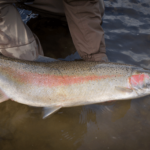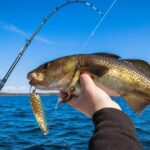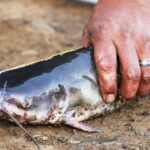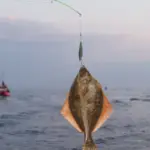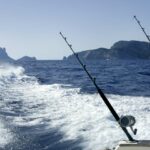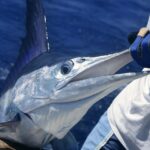Targeting specific fish in large bodies of water like big rivers, lakes, and the sea is very challenging. It can be almost impossible to keep your fishing rig at the right depth, especially when trolling. This is why anglers use downriggers, but are they worthwhile? What fish can you target and catch with a downrigger system?
Using downriggers, you can catch all types of oceanic and freshwater fish, including wahoo, swordfish, marlin, tuna, sea bass, amberjack, flounder, grouper, kingfish, sturgeon, tripletail, steelhead, northern pike, catfish, and even stingrays. Downriggers are very effective for these fish.
There are many ways to fish while trolling and using a downrigger is among the most effective. All it takes is some knowledge of the fish you are targeting and the water you are fishing in, and downriggers can help you catch an astonishingly wide range of fish. Downriggers are very useful, and they can be used in almost any deep water to target specific fish.
What Fish Do You Catch With Downriggers?
Downriggers have been in use in some form since the 1860s and are thought to have been developed to help fishermen catch fish more sustainably and reliably in the Great Lakes in North America.
Downriggers are almost exclusively used while trolling and are designed to target fish at specific depths. This equipment can be difficult to use, and it can be dangerous in some instances, but there are almost no methods more effective for trolling than using downriggers.
This gear can be used in fresh and saltwater and can be set up to catch a very wide variety of fish, depending on how it is used. Downriggers can be used to catch all fish types and sizes, from small to medium fish, large fish, and even monster fish that weigh many hundreds of pounds.
With that said, any angler considering using a downrigger on their boat always asks the same question: what fish do you catch with a downrigger?
This is an important question because downriggers are useless unless you target the right fish and use the equipment in the right way to catch those fish.
There are many various fish species that can be caught with a downrigger, but it is important to discuss freshwater and saltwater fishing separately.
With that said, here are the fish you can catch with downriggers in the ocean and in freshwater.
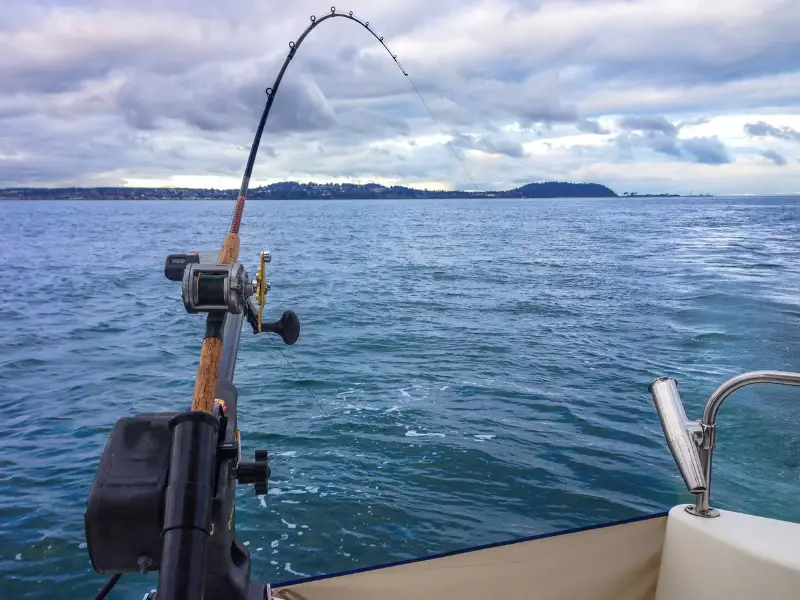
Saltwater Fish To Catch With Downriggers
There are several species of saltwater fish that can be caught with downriggers. These fish are primarily sport fish, bottom feeders, and flat fish that can only be caught at specific depths.
Using a downrigger while tolling in the ocean is very effective when used to target these fish with the correct bait and the right fishing techniques.
The fish you can catch in saltwater with downriggers include:
- Wahoo
- Swordfish
- Bluefish
- Red Drum
- Sailfish
- Blue Marlin
- Yellowfin Tuna
- Bonefish
- Black Sea Bass
- Goliath Grouper
- Tripletail
- White Marlin
- Crevalle Jack
- Barracudas
- Striped Marlin
- Permit
- Bluefin Tuna
- Marlin
- Cubera Snapper
- Greater Amberjack
- Summer Flounder
- Mackerel
There are many other saltwater fish species that can be caught with downriggers, but these are the most commonly targeted.
Downriggers can be deployed on any fishing boat, which means they can be used in any ocean fishing waters internationally, making it possible to catch almost any oceanic fish with a downrigger.
It is, therefore, critical to ensure that you understand the fish in the area that you are fishing and target them accordingly, using the right bait, rigs, trolling techniques and speed, and the correct lures.
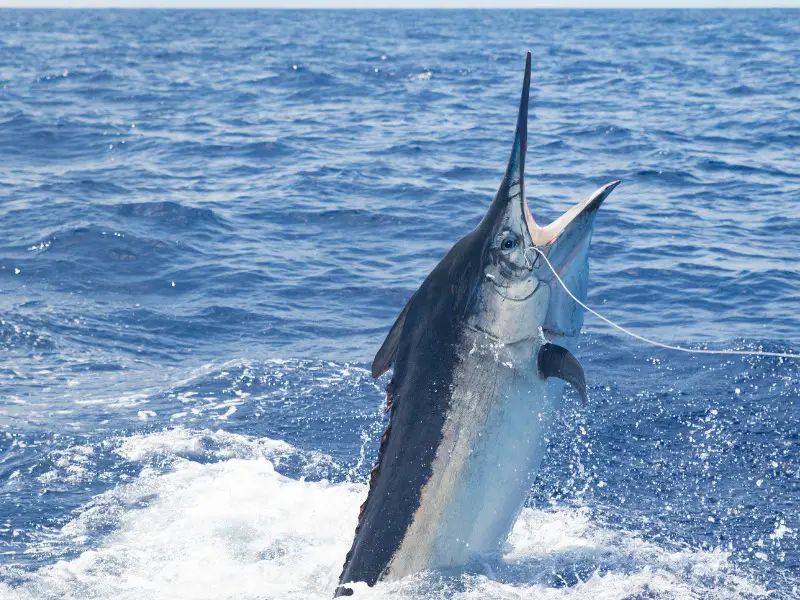
Freshwater Fish To Catch With Downriggers
Downriggers were originally developed for fishing in freshwater. These devices were made for fishing in very large lakes to make catching fish at specific depths more consistent.
This means that there are many species of freshwater fish that can be caught using downriggers.
The fish that you can catch in freshwater using downriggers include:
- Largemouth Bass
- Kurper
- Barbel
- Yellowfish
- Trout
- Salmon
- Catfish
- Northern Pike
- Steelhead
- Kingfish
- Sturgeon
- Alligator Gar
- Perch
- Bullhead
- Paddlefish
- Muskie
- Freshwater Stingrays
These are only a few of the fish that can be caught with downriggers in freshwater, but they are among the most prized and most targeted fish to catch with this type of rig.
Fishing in very large lakes or long rivers can feel impossible. Using downriggers makes it much more successful.
It is still critical to use the right techniques and methods while using a downrigger in freshwater, and it is not the only method for catching fish, but it can make finding elusive fish easier, and you can cover a larger fishing area in big bodies of water in much less time.
Anyone serious about trolling in rivers and big lakes should use a downrigger.
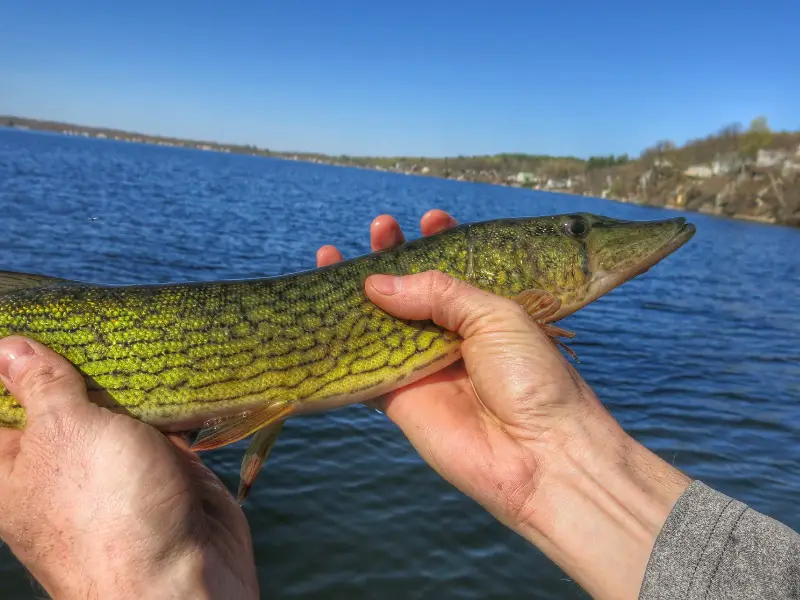
How Do You Target Specific Fish With Downriggers?
We have established that there are several fish species that can be caught using downriggers in fresh and salt water, but it is critical that the correct methods, bait, and techniques are used to catch specific fish, or the downrigger is not likely to be successful.
The type of fish you target determines the rig you use, the way you use the downrigger, the bait or lures you use, and the fishing techniques and methods you use to set hooks.
There are several factors to consider when targeting specific fish, so let’s explore how to target fish with downriggers to use them as effectively as possible.
Use The Right Bait
The first and most important factor when using downriggers to target specific fish species is to use the right bait.
Every type of fish, especially carnivorous fish, has a preferred or more effective bait.
For example, if you target predatory fish such as largemouth bass or marlin, use live baitfish on your rig for the best results.
If you are targeting omnivores, such as carp or catfish, use a commercial bait designed for those fish, or use a bait such as cut fish, crickets, or even shrimp.
Bottom feeders and flatfish can be targeted by using bait such as lugworms, nightcrawlers, and other items that are common on the waterbed of the area you are fishing. This is effective for catfish, barbel, and flounders.
Using the right bait is a highly effective way to target specific fish species while trolling with downriggers.
Fish At The Right Depth
Another important method when fishing with downriggers that helps to target specific fish is to fish at the right depth.
Every fish worth catching dwells in a specific depth range, depending on the season and time of year.
Some fish dwell near the surface, some dwell at the waterbed, and others dwell in suspension a few feet above the waterbed.
It is important to understand the water conditions where you are fishing and the depth that your target fish are likely to be. Every fish has a preferred depth and a depth at which they are most likely to feed.
Learn the behavior of the fish you are targeting, such as what depth they are likely to be at based on their feeding and breeding habit at that time of year, and set your rig to the appropriate depth.
If you use the right bait and the right trolling speed combined with the right depth for the fish you are targeting, your chances of getting a bite are significantly increased without using any other methods.
Troll At The Right Speed
Downriggers are best used when trolling deeper waters. Downriggers are designed to keep bait, lures, and fishing rigs at the desired depth despite the movement of the boat.
However, the trolling speed that the boat moves have a significant impact on the effectiveness of the downrigger and the likelihood of fish taking the bait.
It is important to learn how fast you should troll when targeting certain fish.
Several factors influence the trolling speed that a boat should use, but trolling speed varies from barely moving to 15 knots. This speed is based on the water, the distance you want to travel, the rig you are using, and most importantly, the fish you are targeting.
For example, the ideal trolling speed when targeting a muskie is 2.6 knots, and the ideal trolling speed for crappie is 0.6 knots.
Do the research to find out the speed that your target fish prefers, and you are far more likely to catch what you are after.
A good consideration to remember is that faster-moving fish, especially predatory fish such as marlin and swordfish, will take bait at a much higher speed than other fish, as they are accustomed to hunting at high speeds through the water.
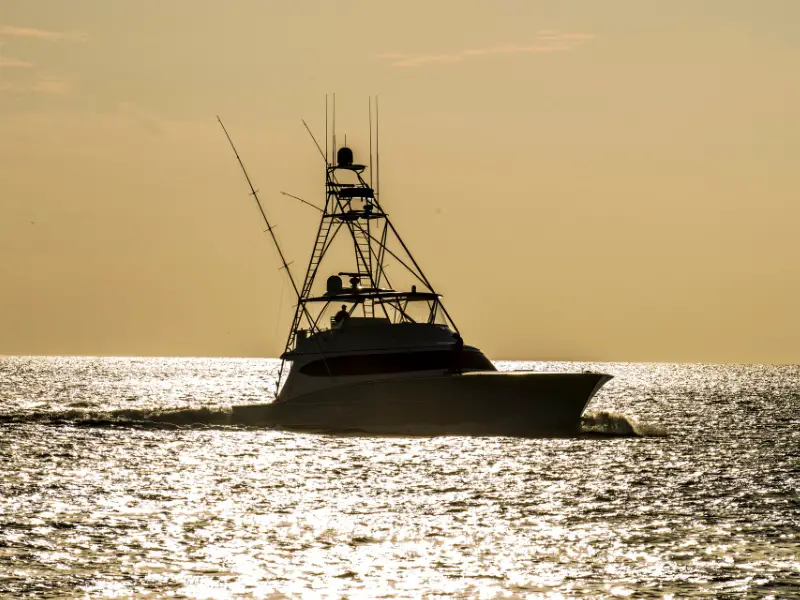
Fish The Right Locations
Trolling is an effective fishing method when combined with tools such as downriggers, but trolling is not effective in every area.
Trolling is best used in areas of deep water occupied by schooling fish or fish that are very aggressive and likely to be attracted to a moving rig.
This fishing technique is not as effective in shallow water, as fish are more likely to be chased away by the boat, and it is less effective when targeting fish that are not very aggressive or those that do not school.
Using a downrigger for trolling is also best used in open water, or very large bodies of water. There are far better techniques for small rivers and lakes that are likely to be much more effective.
It is important to choose the right location for using a downrigger, especially when targeting specific fish. Look for areas where your target fish are likely to be, and try not to waste time in areas where these fish are less likely to be found.
Using a downrigger is never a sure thing, and it is critical to use well-established fishing knowledge and tactics combined with a downrigger for the best results.
Use Depth-Monitoring Fish Finders
The last method here that many anglers like to deploy when using downriggers is a depth-detecting fish finder.
These devices are sonar or radar-based devices that scan the water below the boat for fish. The finder can detect the depth that fish are swimming at, providing critical data for the angle. With the use of a fish finder, you can determine the exact depth to set your downrigger to for your target fish.
Using a fish finder is not necessary, and not all anglers use them, but it is a favorite tool of many anglers who use downriggers, especially when looking for trophy fish.
This combination of gear can be a powerful method for catching the specific fish you want to catch and avoiding any fish you do not want to catch.
Using this combination of gear can even help you make decisions regarding the type of fish you are going to target for the day, what baitfish you are likely to catch, and even what type of rig to use based on depth and water movement.
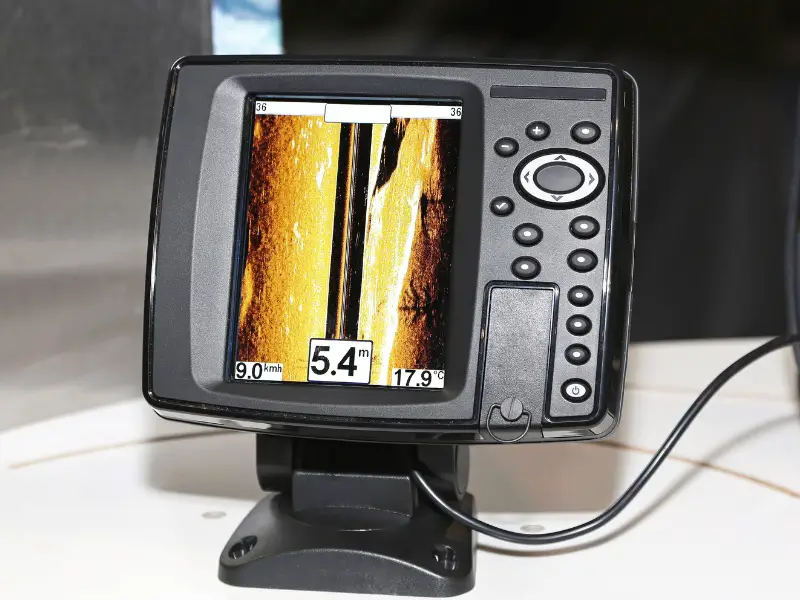
Are Downriggers Effective?
Downriggers can be used to great success, and there are many instances of this equipment being used in various situations and working very well, but how effective are downriggers for everyday fishermen?
Downriggers are very effective. The design of these devices has been refined and honed over several years to the point where many anglers rely on them to catch their desired fish.
Many modern fishing boats never leave the dock without downriggers, and they are considered to be among the most effective tools for fishing in large or open bodies of water.
Downriggers are very effective if they are used well and if they are used in conjunction with effective methods, tactics, techniques, and rigs for fishing. A downrigger alone is not enough to ensure a catch, and it is not enough to guarantee a good fishing day.
However, downriggers can be used to great success if used well, and they are an important piece of gear for anyone catching large fish in open water.
Where To Use A Downrigger
Downriggers can be complex, but the operation of every downrigger unit is functionally the same. There are electric and manual versions and models sold at various prices with various features. However, many anglers using a downrigger for the first time find themselves wondering where to use these devices.
Downriggers were originally designed for use in large freshwater lakes, but these devices can be used in any deep water and have become very common in sport fishing, especially deep-sea fishing.
Still, the best places to use a downrigger are in deeper areas of water, especially where there are schooling fish, large numbers of fish, or predatory fish to be caught.
These fish tend to live in deeper water and are not typically found in the shallows where other fishing can take place more easily.
The purpose of a downrigger is to keep a fishing line at a specific depth while trolling, which also means that the ideal place to use a downrigger is to win very large expanses of water where the boat can easily troll along and cover a good distance to find fish.
You will know where to use a downrigger because this device can only be used successfully and easily in certain depths and sizes of water. In water that is too shallow or too small for a downrigger to be used well, the device becomes cumbersome, slow, and frustrating to use.
Is It Worthwhile Using A Downrigger?
Among the most commonly asked questions regarding downriggers is whether or not they are worth using. Downriggers can be very expensive to buy, install, and implement, and they are known to be dangerous for some boats, even causing some boats to capsize.
This leads many anglers, especially new anglers, to wonder if it is even worthwhile using a downrigger or if they should invest in alternative tools and equipment for their boat.
The reality is that downriggers are worthwhile, provided you use a trolling boat, or you fish in very large bodies of water for larger species of fish.
Average fishermen that fish from simple boats or who prefer fishing in smaller rivers and lakes are unlikely to find much use in a downrigger, even if they fish from a boat.
Downriggers are not designed for small bodies of water, shallow rivers, or very small boats. These devices are made to help keep lures and bait at a desired depth that is generally much deeper than most anglers fish at.
If you frequent the deep water, if you want to catch the biggest fish possible while trolling, or if you seek the best tool for keeping your rigs at the depth they should be in turbulent waters, then a downrigger is the ideal tool for you.
However, if you never venture into deep water, and if your target fish are smaller and easily caught in small bodies of water, a downrigger can be a waste of space on your boat.
Conclusion
There are several types of downriggers to use, and there are different ways to use them, but these devices can be used to catch a very wide variety of fish in any type of water, so long as they are used well.
Downriggers can catch large, medium, and small fish, depending on how you use them, but they are primarily used to catch larger fish, trophy fish, predatory fish, and fish that are commonly found in deeper water in large lakes and in the ocean.
- Do You Need An Indicator For Nymph Fishing? - November 16, 2023
- Fishing Safety Tips For Families - September 25, 2023
- What Is The Best Time To Night Fish At A Lake? - September 18, 2023

